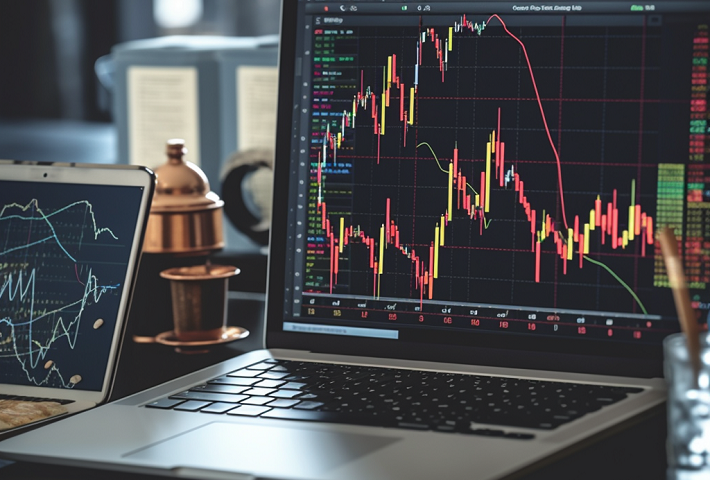Technical analysis has a history spanning nearly three centuries, with the use of indicators and the plotting of technical charts being observed in manuscripts dating back around three hundred years. The first significant application of this analysis was made by Charles Dow, who is considered the founder of the Wall Street Journal and succeeded in creating an index later named the Dow Jones Industrial Average in his honor.
Technical analysis is one of the most important methods for analyzing financial markets, based on historical price and trading volume data. It can be regarded as the most common and popular way to assess the market and predict price trends. By using technical analysis and analytical tools, one can determine suitable entry and exit points for an asset, as well as stop-loss levels in a trade, ultimately aiming for profitable outcomes. In technical analysis, price charts, trading volume, the overall market situation, and price trends of various assets are examined. In other words, technical analysis can be seen as determining a trading strategy aimed at assessing an investment and identifying trading opportunities. Essentially, technical analysts use the statistical trends of an asset, price fluctuations, and the trading volume of that asset to predict its future price.
Important Notes:
- In markets with natural price trends and high trading volumes, more reliance can be placed on technical analysis. Thus, the higher the trading volume in a market, the less manipulation of prices and consequently, the reduction of abnormal market fluctuations.
- This method is primarily utilized by short-term traders, while fundamental analysis is more often employed by investment funds and long-term investors.
Disadvantages of Technical Analysis
- Predicted results are not guaranteed to be 100% accurate.
- The analytical methods used by analysts heavily influence their predictions.
- Some experts consider this analysis method somewhat unreliable and refer to it as a self-fulfilling prophecy. In fact, they believe that individuals using this analysis are somewhat justifying their trading behaviors through numbers and mathematical logic. According to the self-fulfilling prophecy theory, an event occurs when many people believe it will happen.
- Different indicators may provide varying buy and sell signals.
- Fundamental Principles of Technical Analysis
The principles embedded in Dow Theory can be considered the fundamental basis of technical analysis that every technical trader should pay attention to.
- Price Discounts Everything: Technical analysts believe that the price of an asset reflects all existing information (economic, political, etc.). Therefore, studying historical price data is sufficient. The main element of technical analysis is supply and demand, which essentially represents market sentiment. This factor suggests that the price of an asset can be viewed as a result of the interaction of buying and selling pressures, which are directly related to traders’ sentiments (fear and greed). Analysts should focus more on the price itself rather than the variables affecting it.
- Price Moves in Trends: Markets generally move in upward, downward, or sideways trends. Analysts strive to identify these trends and capitalize on them.
- History Tends to Repeat Itself: Markets tend to repeat historical price patterns, and analysts use these patterns to forecast future movements. Technical analysis is conducted based on past and current prices of a stock or asset, with the basic assumption that the price trends of an asset are not random, and history repeats itself. According to this perspective, technical analysts can predict future price trends of an asset by examining its historical price data and using the patterns formed in its corresponding price charts.
- Types of Charts
- Line Chart: The simplest type of chart that displays price over time, including only closing prices.
- Bar Chart: Each bar represents the opening, highest, lowest, and closing prices (OHLC) for a specified time frame.
- Candlestick Chart: Similar to the bar chart but provides a more visually appealing presentation with more visual information. Each candlestick represents price fluctuations over a specific time period. Most market analysts consider candlestick charts as the best option for market analysis, as they can provide daily price changes of each cryptocurrency based on changes in each candle.
- Tools of Technical Analysis
- Indicators: Indicators are among the most essential tools used in technical analysis. They help identify current trends and provide valuable information about future trends, increasing the efficiency and speed of analyses. Since indicators can also generate errors, professional traders often use multiple indicators simultaneously to reduce the risk of their analyses. Indicators assist analysts in identifying trends and buy/sell signals. Some common indicators include:
- Moving Average (MA): The average price of an asset over a specific time period, which can help identify trends and reversal points.
- Relative Strength Index (RSI): This indicator indicates overbought or oversold conditions of an asset and can provide reversal signals.
- MACD (Moving Average Convergence Divergence): A trend analysis tool that detects buy and sell signals based on the crossing of moving averages.
- Trend Lines: Trend lines are drawn on charts to indicate the direction of price movement. Analysts can draw upward trend lines (which guide prices upward) and downward trend lines (which guide prices downward) to identify entry and exit points. Trend lines are a crucial factor considered by cryptocurrency traders, allowing them to identify future prices based on historical peaks.
- Support and Resistance Levels
By identifying these horizontal levels, we can analyze the recent supply and demand for the cryptocurrency in question and make predictions based on these analyses.
- Support: A price level where demand is sufficient to prevent further price declines. When the price approaches a support level, the likelihood of a price increase exists.
- Resistance: A price level where supply is sufficient to prevent further price increases. When the price approaches a resistance level, the likelihood of a price decline exists.
- Price Patterns
Price patterns can help identify future trends. Types of price patterns include:
- Continuation Patterns: Indicate that the current trend will continue (e.g., triangles, flags, and wedges).
- Reversal Patterns: Indicate a potential change in trend (e.g., head and shoulders, double tops, and double bottoms).
- Buy and Sell Signals
Buy and sell signals help traders identify the right time to enter and exit the market. These signals can be derived from indicators, price patterns, or support and resistance levels.
- Risk Management
Risk management is a crucial component of any trading strategy. Some key principles of risk management include:
- Using Stop Loss: Setting a point at which a trade should be closed to prevent further loss.
- Using Take Profit: Setting a point at which a trade should be closed to realize profit.
- Diversification: Investing in different assets to reduce risk.
- Trading Strategies
Technical analysts can select from various trading strategies, including:
- Day Trading: Buying and selling assets within a single day.
- Swing Trading: Holding assets for several days or weeks.
- Position Trading: Holding assets for a longer duration, typically several months or even years.
Key Considerations for Success in Technical Analysis
- Continuous Learning: Ongoing education about new tools, indicators, and patterns.
- Practice: Using demo accounts to practice strategies without financial risk.
- Review and Analyze Past Trades: Learning from successes and failures to improve strategies.
Technical analysis is a powerful tool, but it requires practice and continuous learning to achieve desired results.


